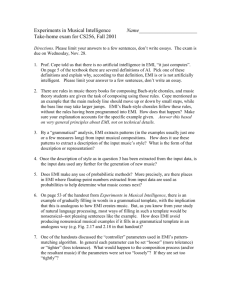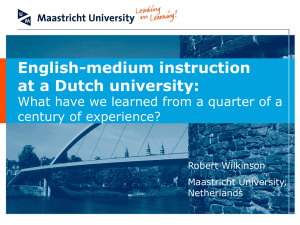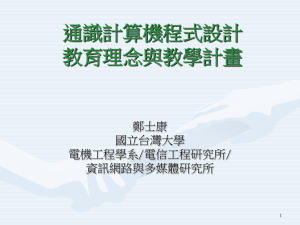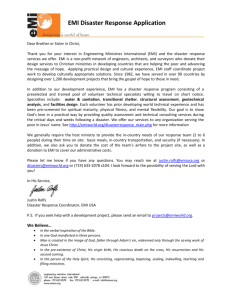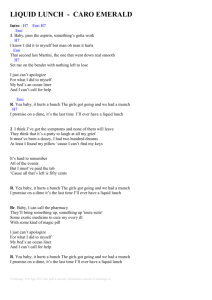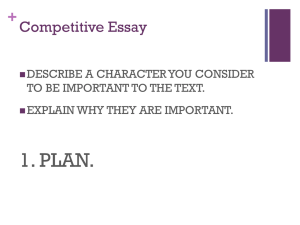extending access for academics employees
advertisement
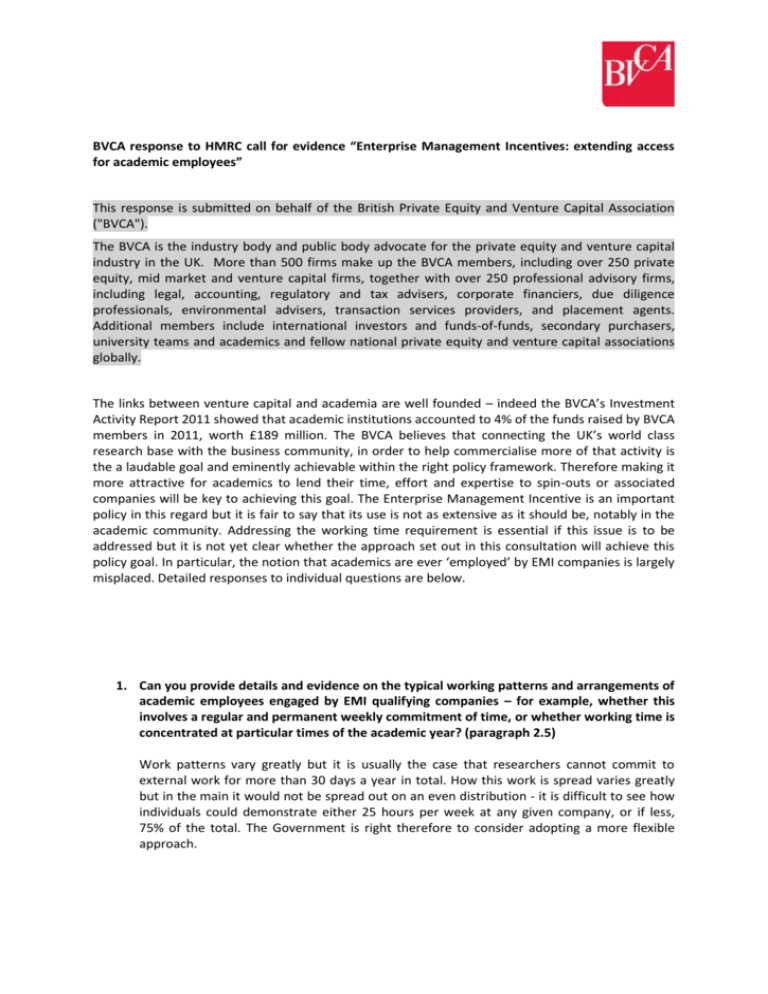
BVCA response to HMRC call for evidence “Enterprise Management Incentives: extending access for academic employees” This response is submitted on behalf of the British Private Equity and Venture Capital Association ("BVCA"). The BVCA is the industry body and public body advocate for the private equity and venture capital industry in the UK. More than 500 firms make up the BVCA members, including over 250 private equity, mid market and venture capital firms, together with over 250 professional advisory firms, including legal, accounting, regulatory and tax advisers, corporate financiers, due diligence professionals, environmental advisers, transaction services providers, and placement agents. Additional members include international investors and funds-of-funds, secondary purchasers, university teams and academics and fellow national private equity and venture capital associations globally. The links between venture capital and academia are well founded – indeed the BVCA’s Investment Activity Report 2011 showed that academic institutions accounted to 4% of the funds raised by BVCA members in 2011, worth £189 million. The BVCA believes that connecting the UK’s world class research base with the business community, in order to help commercialise more of that activity is the a laudable goal and eminently achievable within the right policy framework. Therefore making it more attractive for academics to lend their time, effort and expertise to spin-outs or associated companies will be key to achieving this goal. The Enterprise Management Incentive is an important policy in this regard but it is fair to say that its use is not as extensive as it should be, notably in the academic community. Addressing the working time requirement is essential if this issue is to be addressed but it is not yet clear whether the approach set out in this consultation will achieve this policy goal. In particular, the notion that academics are ever ‘employed’ by EMI companies is largely misplaced. Detailed responses to individual questions are below. 1. Can you provide details and evidence on the typical working patterns and arrangements of academic employees engaged by EMI qualifying companies – for example, whether this involves a regular and permanent weekly commitment of time, or whether working time is concentrated at particular times of the academic year? (paragraph 2.5) Work patterns vary greatly but it is usually the case that researchers cannot commit to external work for more than 30 days a year in total. How this work is spread varies greatly but in the main it would not be spread out on an even distribution - it is difficult to see how individuals could demonstrate either 25 hours per week at any given company, or if less, 75% of the total. The Government is right therefore to consider adopting a more flexible approach. 2. Would the proposed definition of an academic employee be effective in meeting the policy objective? If not, what alternatives could be used? (paragraphs 2.7 - 2.11) 3. Are there any cases where this proposed definition might exclude academic employees that ought to be covered by any relaxation of the working time requirement? Please provide specific examples. (paragraphs 2.7 - 2.11) We have no objection to the current definition of ‘research institution’ being used and indeed this approach makes sense wherever it is appropriate to use existing legislation. However the definition says ‘in addition to their employment on the business of an EMI company’. Feedback from BVCA portfolio companies suggests that this could exclude the vast majority of academics operating in this space. Whilst said academics are employed by the academic institution, when they do go out to an EMI company, it is not generally as an employee of that company. Usually the legal relationship is one of ‘consultant’ or ‘contractor’. Indeed occasionally it could be a form of directorship which again wouldn’t necessitate an employment relationship. The terminology therefore needs to be expanded beyond just that of an employer-employee relationship. 4. Is a modified working time requirement for academic employees a suitable approach? If not, what alternatives could be used? (paragraphs 2.12 - 2.19) 5. If a modified working time requirement for academic employees was adopted, what would be a reasonable average working time to be spent on the business of the EMI company, based on current practice; and over what period of time should this be applied? For example, it could be a set number of hours over a week, or over a longer period of time. (paragraphs 2.12 - 2.19) 6. Are there any cases where the proposed modified working time requirement for academic employees would be too restrictive? Please provide specific examples. (paragraphs 2.12 2.19) Following on from the above, it is difficult to see how using a modified working time requirement in order to expand the use of EMI would greatly increase the population of participants. This is unless the aggregated time includes that spent acting as a consultant or contractor for a qualifying company. It is not therefore clear that this approach is flexible enough to cater for what is common practice when academic institutions interact with EMI companies. It terms of the reasonable average working time metric, maximum flexibility here is essential and should not include set hours per week. At best this should be an average over as large a time period as possible. Otherwise because of the concentrated nature of the work, few would pass the test and qualify for EMI. 7. Would the proposed condition that the academic employee's work for the EMI company must be relevant to the academic discipline for which they are engaged by the research institution be a suitable approach? If not, what alternatives could be used? (paragraph 2.21) 8. Do you have any views on the relative merits, including potential scope, impact, costs and benefits, of the two proposed alternative approaches to defining the type of work the academic employee must be carrying out for the EMI company in order to benefit from the new relaxation? (paragraphs 2.22 - 2.32) Given the cyclical and sometimes concentrated nature of the work involved when an academic contracts with an EMI company, the meeting of even the modified working time requirement will depend entirely on how the definition of ‘relevant’ is drawn. Our concern is that if Government seeks to draw too direct a read across from the research activities at the institution and activities at an EMI company, too many academics would fail to qualify. Activity directed towards either IP or R&D needs to be considered at a strategic level as that is the capacity that an academic ‘consultant’ may act for an EMI company. The notion that precisely the same skills and activities are deployed in both places is misplaced. There are two types of relationship that a university commonly stands in with a company; a direct spin out or a more arms length arrangement. It might be that in the case of a spin-out there is a very direct correlation between the work but in an arm’s length relationship, common in university clusters, such companies may wish to contract with academics at a senior strategic level; for example as non-executive directors. These individuals add a huge amount of value and are essential in speeding the growth and commercialisation of universities world class output. However they may not pass the relevance test as currently drawn. 9. Overall, do these proposals represent an appropriate and workable basis for relaxing the EMI working time requirement for academic employees? (paragraphs 2.33 - 2.34) 10. What impact would these proposals have for the number of academics eligible to receive EMI share options? (paragraphs 2.33 - 2.34) In their current form we do not anticipate that these proposals will be workable in attempting to relax the working time directive. Our feedback suggests that as the vast number of individuals concerned are not ‘employed’ by EMI companies, the number of eligible academics will not materially increase as a result of these changes. 11. Would these proposals present any difficulties of implementation for businesses? (paragraphs 2.33 - 2.34) 12. What impact would these proposals have for businesses in terms of one-off or continuing costs / savings? (paragraphs 2.33 - 2.34)

